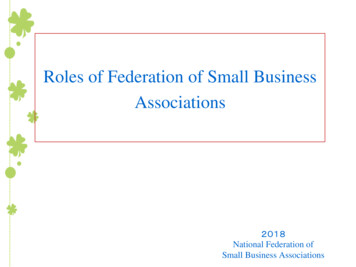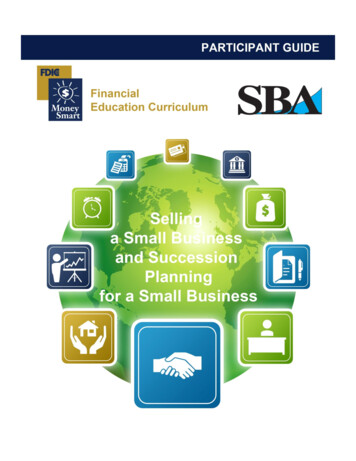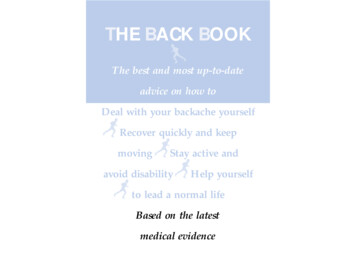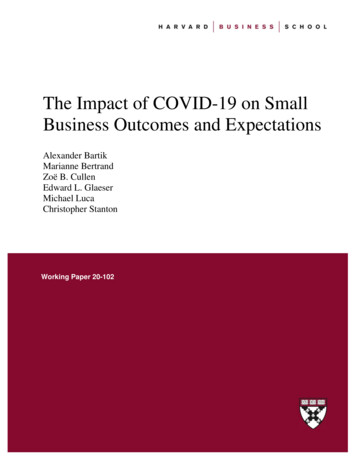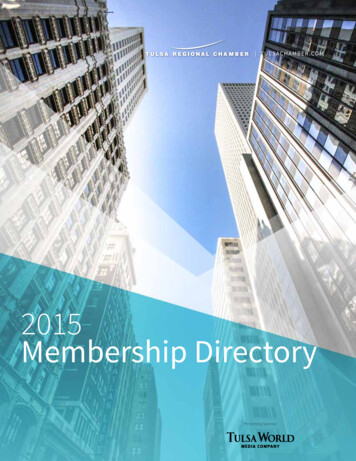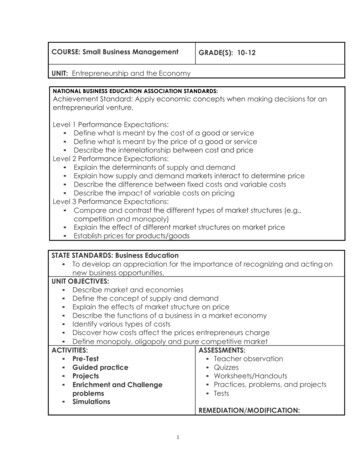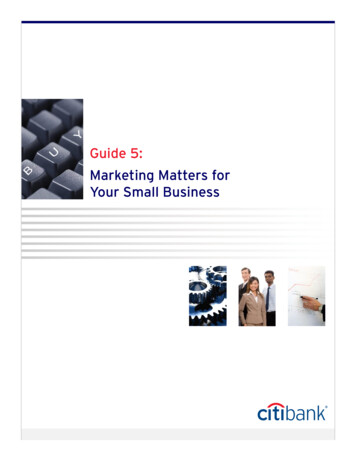
Transcription
Get backto businessA guide to recovering from disaster
CONTENTSIntroduction3The Stages of Getting Back to Business41. Monitor and Respond5Monitor the Impending Emergency Checklist6During the Emergency Event Checklist8NSW Emergency Services Information9Tropicana Fruit Shop Case Study10BIG4 Tathra Beach Holiday Park Case Study112. Early Recovery12The First Hours Checklist13The First Days Checklist16Tathra Beachside Holiday Park Case Study203. Mid-term Recovery21Mid-term Recovery Checklist22Dungog Tyre Service Case Study254. Long-term Recovery26Long-term Recovery Checklist27Blend Providore Case Study29Making the decision to close your business305. Building Back BetterGodfreys Lismore Case StudyKey Links and Resources313233
INTRODUCTIONWhen disaster hits your business, what do you do? Withthe frequency and severity of natural disasters increasingin Australia, that’s something all businesses owners need toask themselves. Whether it’s flood, fire or a cyber-attack, theconsequences can be devastating. Preparing for a disasteris simply good business. It could be the difference betweenyour business being out of action for a few days or never reopening at all.After a disaster, the process of recovery can seem overwhelming, particularly when youdon’t have a plan.How to use this documentThis guide contains five phases of disaster recovery you would generally expect - fromthe moment the disaster has hit, to the actions you could take over the days, weeks andmonths ahead. The action checklists allow you to work through the phases of recovery in an easy to usestep-by-step manner. The case studies highlight lessons learned by other small businesses when they had to faceand recover from disaster. The directory of links and resources contains details of emergency services and otheragencies with a small business recovery focus.Other ResourcesThe Insurance Claims for Small Business Guide is a helpful resource to use for your businessrecovery along with the resources on recovery listed at the back of the guide.NSW Small Business CommissionA guide to recovering from disaster3
THE STAGES OF GETTINGBACK TO BUSINESSThis guide has been brokenup into five stages to give youand your business the rightinformation at the right RecoveryEarlyRecovery31Mid-termRecovery2234Monitor veryBuilding BackBetterMonitor theemergency to keepyourself, your family,staff and customerssafe and secure yourpremises when anemergency isimminent orunderway.Prioritise whatactions you need totake, start early onyour recovery, suchas collectingevidence forinsurance claims,and ask for helpfrom volunteers.Check in on yourown and staff’shealth while youcontinue to pursueyour insuranceclaim(s), and let yourcustomers andsuppliers know if/when you’re openfor trade.As your businessoperations becomesless defined by theemergency but asyour new ‘businessas usual’, you coulddevelop a hazardspecific action planbased on yourexperiences.Acting on what youhave learnt will helpyou prepare forfuture events andimprove yourbusiness plans andactivities.NSW Small Business CommissionA guide to recovering from disaster54
1Monitor & RespondBe aware and take appropriate actionThere are key things that youcan do when an emergencyevent is imminent or underway.BuildingBackBetterBefore disaster strikes Be aware and know where to go and when toact to protect your business. The Get Ready Business toolkit can help guideyou through preparing for a disaster oremergency event. Keep yourself, family, staff and customers ry Minimise the risks on and around your premises. Have an emergency action plan in place. Thiswill help you think clearly in the event of anemergency and keep your business operatingas long as possible.53Mid-termRecovery2During the Disaster Connect with relevant emergency services. Stay up to date with disaster information inyour area. Keep yourself, your family, staff andcustomers safe. Action your emergency plan.“Staff are a vital part of the responseand recovery process. Prioritise themin your response and recovery plans.And plan absolute worst case. A solidPlan B is planning for the worst case.It will all happen again. And again.We’ve had droughts and fires beforeand we will again.” - Shelley Piper andMatt Cherry, ‘Trio Angus’, Upper HunterValley NSW.NSW Small Business CommissionA guide to recovering from disasterTIP Prepare a pack of allessential items includingdocuments you may needin an emergency. Store thiskit in an easy-to-accesslocation and have digitalcopies in the Cloud. Moreinformation can be found inthe Get Ready Businesstoolkit5
Monitor & Respond1Monitor the Impending Emergency ChecklistTASK1BE READY2HEALTHAND SAFETYACTIONKEEP IN MINDI mplement your BusinessContinuity Plan. The hazard may be bigger than yourprevious experience or expectations.M onitor information sources. A Business Continuity Plan should beregularly reviewed.Keep yourself, your family, staff andcustomers safe. Review your evacuation plans witheveryone present. Decide if it is safe to evacuate. Evacuate early if you, your staff or yourcustomers are in danger or likely to bein danger. Monitor a couple of sources of reliableinformation regarding the emergency athand (see page 9). Visit the NSW Health’s webpage:Maintaining health during and after floodsand storms Take your emergency essentials kit(in a waterproof container) and somecash when you evacuate. Monitor local conditions in case thesituation changes quickly. Monitor news and information sourcesfor updates.3PREMISES:SECUREAND PROTECTPrepare your premises. Switch off mains electricity,if appropriate. Switch off gas mains (if installed). Minimise any risks on and aroundyour premises, e.g. unplug sensitiveor expensive equipment, turn onsprinklers if a fire is approaching andelevate stock and fittings in the eventof flood. Remove stock or valuable business itemsfrom your premises. TIP remove the most valuable or necessaryitems first. Secure your premises as much as you can.This may mean closing or opening doorsdepending on the hazard (e.g. openingdoors to let floodwaters recede). Secure your assets and premises. Implement your emergency actionplan (e.g. flood or bushfire plan)./ continued overNSW Small Business CommissionA guide to recovering from disaster6
Monitor & Respond1TASK4TECHNOLOGYAND BUSINESSRECORDSACTION Secure business information, recordsand data. Take enough systems and informationto set up a remote office. Secure key equipment and ensure allkey data has been backed up.5COMMUNICATE Call emergency contacts. Contact customers and suppliers toinform them that your business maybe affected.KEEP IN MIND Normal communications channels may notbe operational, so ensure you have at leastone alternative (e.g. divert your landline toa mobile or use two-way radios). Contact your telecommunications providerearly to seek support and assistance. Use your emergency contacts list to tellimportant contacts where you are andyour situation. If you can’t communicatefor a few days due to phone outages, yourcustomers and suppliers will know why. Use social media channels, if you havethem, to provide updates on yourbusiness.6 Assist others if possible.CONNECTNSW Small Business CommissionA guide to recovering from disaster If you are fully prepared for the event, youmay be able to assist your neighbours orother local businesses to prepare.7
Monitor & Respond1During the Emergency Event ChecklistTASK1HEALTH ANDSAFETYACTION Stay safe. Don’t risk your life or thelives of your family, staff or customers. Enact your evacuation plan andevacuate only when safe to do so.KEEP IN MIND Follow the emergency action plan for yourbusiness and ensure clear communicationwith your staff. Depending on the type of emergency,changes to normal procedures may berequired, e.g. boiling drinking water. Keep an eye on neighbours andcommunity members. Offer assistancewhere possible and safe to do so.2COMMUNICATE Keep monitoring the emergencywarnings and alerts (see emergencyservices information on followingpage.). Assign this task to someone inyour team, if you have one. Mobile phone and landlinetelecommunications may not work inan emergency. Plan for a back-up communicationsmethod, in case the existing networkdoesn’t work (e.g. divert phones oruse UHF radios).3CONNECT If you have evacuated, registereveryone in your group withemergency services at a localevacuation centre, or online, throughthe Australian Red Cross Register,Find, Reunite website:register.redcross.org.auNSW Small Business CommissionA guide to recovering from disaster In some situations where a mandatoryevacuation has been ordered (e.g. if abomb was discovered in or near yourbusiness premises) you may need toconfirm with the police or emergencyservices that you have evacuated yourbusiness premises.8
Monitor & Respond1NSW EMERGENCY SERVICESINFORMATIONDial 000 Triple Zero for Police, Fire or Ambulance for life threatening emergencies. Ifyou are deaf or have a speech or hearing impairment dial 106 for the Text EmergencyRelay ServiceWebsites for NSW emergency service are listed here:NSW Rural Fire Service www.rfs.nsw.gov.auNSW State Emergency Service www.ses.nsw.gov.auFire and Rescue NSW www.fire.nsw.gov.auNSW Police Force www.police.nsw.gov.auBureau of Meteorology www.bom.gov.auHelpful Apps:Fires Near Me NSWLife Traffic NSWEmergency Other useful sources of information to keep you up-to-date:checking with your local council website for information on recovery and supportonline up-to-date disaster information at: abc.net.au/news/emergency tuning in to your local radio station (locate your radio frequency at:abc.net.au/reception/freq/NSW Small Business CommissionA guide to recovering from disaster9
Know your risks and beprepared to act quicklyBusiness owner, Alex Coronakes, knows from firsthand experiencethat understanding and monitoring the risks that are likely to affectyour business can help you avoid or at least minimise losses in the faceof disaster.In the days just before the 2017 Lismore Flood, Alex Coronakes was driving home from Brisbane and noticedthat there was a lot more water in the Wilsons River at Nashua, north-east of Lismore, than usual. When hegot to Lismore, he rang some mates for updates on water levels in the surrounding area and was convincedthat the CBD would flood.Alex made a quick decision to close the shop at midday. The family returned at 3pm and were all packed upby 7.30pm, well in advance of the flood which overtopped the levee the next morning. Unfortunately, manyof the other shops in Lismore left it too late and did not fare so well.Alex’s adviceAlex credits experience and being aware of the weather to saving the shop and his stock, many times over.He said, “Don’t be complacent. You have to be prepared and don’t wait until the last minute. If you pack upand nothing happens, it doesn’t matter. If you don’t pack up or wait until the last half-hour it’s too late andall hell breaks loose.”Tropicana Fruit Shop Lismore NSW10
Safety in ‘the cloud’ –why remote access to businessrecords is importantThe owners of Big 4 Tathra Beach Holiday Park, Greg and Kerry McKay,can attest to just how important having access to business records andsystems are in an emergency.Six months before the 2018 Tathra bushfires, Greg moved the Holiday Park’s computer-based reservationssystem to a new cloud-based system. That decision meant that when Greg and Kerry had to evacuate thePark and shut their office, they were able to log into their reservations database from any computer,anywhere.With Greg and Kerry literally in the line of fire they were able to redirect the Holiday Park’s phone to themobile phone of their daughter, Katie. From her home 450km away in Sydney, Katie took over responsibilityfor managing reservations and communicating with current and future guests via group SMS messagesand emails.“Our guests told us our communications were fantastic. When the police opened up the town temporarilyso guests could get their caravans out, we were able to send them a text and I was able to meet them onsite to give them a hand to pack up,” Greg said.Although the Holiday Park sustained very little damage, Greg and Kerry lost their house in the bushfires. Thefollowing weeks and months were very difficult but Greg said that knowing his business records weresecure and his customers were well informed, he was able to focus on other things. He even found time tohelp the local community with supply runs between the recovery centre and the showgrounds, and whenthe town was permanently opened again, he was able to concentrate on getting the Park re-opened.Greg and Kerry McKay of BIG 4 Tathra Beach Holiday Park, Tathra NSW.11
2Early RecoveryThe first hours and daysBeing organised andknowing what to do will helpyou take advantage of thehelp on offer during the earlyrecovery phase. Enlist the help of volunteers – utilising theirhelp in the physical recovery can free youup to think about how your business maybe affected in the months and years ahead. Stay alert to any further dangers. Record the damage (photos or videos) andcontact your insurer as soon as you can.Make good records of the event and itseffects on your business. And get insuranceadvice before cleaning ryLong-termRecovery3Mid-termRecovery2 Delegate tasks – This may be to your staff,volunteers or to the professionals whousually support you (e.g. your insurancebroker, accountant, suppliers,subcontractors or tradespeople).“Tradies can help with your recordkeeping and paperwork. They cantake photos of damage you may notbe able to see, take photos duringrepairs, and also help withinformation for your developmentapplications.“ - Tracey Lowrey, ‘BryanLowrey Builders’.NSW Small Business CommissionA guide to recovering from disasterTIP Remember to ask forhelp. Volunteers are oftengrateful for the chance to dosomething to help.Communicate early aboutyour business’ situation withbusiness partners, customers,suppliers, your bank and yourinsurance company.12
Early Recovery2.1Early Recovery – The First Hours ChecklistTASK1HEALTH ANDSAFETYACTION Return to your business site onlywhen safe. Protect yourself, your family, and yourstaff when returning to your businesssite. Stay alert to dangers if the emergencyevent is not yet resolved.KEEP IN MIND Seek information from emergencyservices or your local council aboutreturning to the disaster affected area. Common risks and dangers immediatelyafter a crisis are flooded roads, damagedand falling trees, tetanus, contaminatedwater, and exposure to asbestos. Wear protective clothing, hats, gloves,and boots that protect your feet and legs. Floodwaters could be contaminated withsewage or be hiding sharp items. Burned or damaged premises can containdangerous substances, such as asbestos. Roof-mounted solar panels and/orbattery systems should be inspected by alicensed electrician if possibly affected. The following guides may be helpful: Maintaining Health and Personal Safetyduring and after floods and storms –NSW Health After a Flood – NSW SES What to do after the fire –Fire and Rescue NSW NSW SES Recovery Guide2STAFF Check that your staff and their familiesare OK. Find out if and when staff can returnto work. Provide staff with information aboutyour plan for recovery, if appropriateto do so. Let staff know you care and want tosupport them as best you can. See how ready they are to assist and getback to business. The following guides may be helpful:Employment Entitlements During NaturalDisasters or Emergencies –Fair Work OmbudsmanYour workplace rights during naturaldisasters and emergencies –Legal Aid NSW./ continued overRefer to the back of the guide for the directory of key links and resources.NSW Small Business CommissionA guide to recovering from disaster13
Early Recovery2.1TASK3PREMISES ANDCONTENTS:DAMAGEASSESSMENTACTION Record the damage – photos orvideos are essential. Contact your insurance company,insurance broker, or insuranceconsultant as soon as you can. Consider relocating your businessoperations to a temporary locationif your premises are damaged orinaccessible. Recover items that can be saved orrepaired. Estimate repair, replacement and/orrelocation costs.KEEP IN MIND Take photos and videos before youclean up, during the clean-up, and whencomplete. Photos and videos can be usedto demonstrate your losses, not just forinsurance. Confirm your ability to clean up without itimpacting any insurance claim. Insurancerules vary for different types of hazards. You may need to separate the list ofdamages to your contents and tools,even if covered by the same insurancecompany. Useful resource:Property Hazards post storms / floods –Safework NSW.Damage Assessment Checklist and CostTemplate – CPA Australia.4INSURANCE Don’t wait for a full damageassessment to lodge a claim. Ask about the level of supportyour policy provides for immediatebusiness relief, temporaryaccommodation and recovery advice. In large disasters, insurance services canbe overwhelmed. Early contact helps. If you have one, working through yourinsurance broker can assist claims. Recovering From a Disaster is a usefulresource from Understand Insurance. If you lose insurance documents in theemergency, your broker or insurancecompany will have copies. The Insurance Council of Australia (ICA)can help if you can’t remember who youare insured with. Ph: 1800 734 621 You may not be covered for unauthorisedrepairs, so speak to your insurer. Insurers may ask you to minimise loss anddamage e.g. by tarping a damaged roofor securing undamaged goods. Contact the Australian FinancialComplaints Authority on 1800 367 287 toaccess free dispute resolution if you havea complaint.5INDUSTRYREGULATIONS Contact your council or industryregulator to see if there are thingsyou need to be aware of prior to reopening. If you sell food, you may need anenvironmental health inspection beforeyou can return to trading./ continued overNSW Small Business CommissionA guide to recovering from disaster14
Early Recovery2.1TASK6RECORD KEEPINGACTION As soon as you can, and regularly,make good records of the event andits effects on your business.KEEP IN MIND Notes are vital to help you rememberinformation. So much is going on and youmay not remember everything. Methods for keeping records includenotebooks, voice recording into yourphone, email or texts to yourself or atrusted person, or videos. Record a date and time for each note. Record actions, key names and phonenumbers. Your records can help with a businessimpact statement. That could allow accessto additional support or funds. Tick things off when you’re done. As thereis so much to do it helps to know you aremoving forward.7COMMUNICATIONS Keep in close contact with otherbusiness owners, council and localemergency services to ensure youhave the latest information on thebroader recovery effort.NSW Small Business CommissionA guide to recovering from disaster Plans for clean-up efforts, road closuresetc. may impact on your business.15
Early Recovery2.2Early Recovery – The First Days ChecklistWhile early action can help the speed and effectiveness of recovery, this may not be the best time for big decisionsabout the future of your business.The first few days may be a good time to get help from professionals including your insurance broker, accountant,builder or others related to your line of business.TASK1HEALTH ANDSAFETYACTION Take care of yourself, your family andfriends. You may need time to recover from yourinjuries. Ask for help for anything you can’tmanage. You may be feeling overwhelmed or needtime to come to terms with what hashappened. Take time out as you go throughrecovery.Engage a licensed electrical contractor toinspect your electrical outlets and wiring ifthey were affected.Engage a licensed gasfitter to inspectany LPG or natural gas appliances andequipment if they were affected.2STAFF ANDVOLUNTEERSKEEP IN MIND Offer support to your staff if they havebeen affected or are distressed. Give staff information about your planfor recovery, if appropriate to do so. Accept volunteer help when offered. You may not be in a position to focuson your business or your staff. This maydepend on the loss or damage you or yourbusiness have suffered, or your experiencesduring the emergency. Feeling overwhelmed is bothunderstandable and temporary – you willbe able to make decisions about your lifeand your business again. Staff often want to get back to work anddoing this may help everyone’s recovery. Staff may also need to take unpaid leave toassist with broader emergency efforts. Accept help, even if you believe there areothers who need it more. In the early daysof disaster recovery, there is often plenty ofhelp available for everyone. Be organised to make the most of yourhelp. Give clear instructions and check inon volunteers regularly. Using similar staff processes for volunteerscan help e.g. make sure volunteers sign inand out and are supervised where possible. You have a duty of care to volunteersworking in your business./ continued overNSW Small Business CommissionA guide to recovering from disaster16
Early Recovery2.2TASK3FINANCIALRECOVERYACTION Assess how long you can continuewith reduced or no revenue. Contact lenders, creditors and debtorsearly to discuss options, e.g. you maybe able to explore if you can applyfor a temporary variation to your loanobligations. Access financial help on offer. Begin planning for your longer-termfinancial recovery.KEEP IN MIND Assess your financial reserves, or lines ofcredit for early financial recovery. Banks, lenders and creditors are sometimeswilling to defer payments after a disaster. Interest-free micro loans, through providerslike Good Shepherd, may assist in theshort term. Interest only payments on loans may assistin the short term. Debtors unaffected by the event may beable to pay more quickly than usual. The Australian Taxation Office cansometimes approve deferrals of taxpayments. Government Disaster Grants and Loansinformation is available through the NSWOffice of Emergency Management. Your accountant may be able to assist yourfinancial recovery planning. Business Connect advisors can point youtoward financial assistance. Local industry or business organisationse.g. Chamber of Commerce may be ableto assist. The Disaster Recovery Toolkit, releasedby CPA Australia is also a useful resource.Download it at: www.cpaaustralia.com.au/ sources/business/disaster-recovery-toolkit.pdf/ continued overNSW Small Business CommissionA guide to recovering from disaster17
Early Recovery2.2TASK4PREMISES:REOPENING YOURBUSINESSACTION Get insurance advice beforecleaning up.Consider all options for reopening,including: reduced hours temporary premises alternative locations different business models(e.g. online sales).KEEP IN MIND Insurance may cover clean-up costs,especially if there is a lot of debris. Dangerous demolition or asbestos removalmay be supported by your insurance orlocal council. Your local council may offer cleaningsupport, rubbish removal or kerbsidepick-up. Other assistance for your clean-up may beavailable from family, friends, colleagues orvolunteers. Consider alternate ways of runningyour business e.g. online sales, servicesor advice. If your business is partially damaged,consider operating with reduced hours orlimited products or services. Temporary locations may include businesscentres, libraries, a hotel, someone’s homeor sharing with another business. Consider a virtual office (telephoneanswering service, mail forwarding or aremote secretarial service). Reopening your business helps your staff,customers and community recover.Useful websites and resources: Recovering From a Disaster - UnderstandInsurance Website. After a Flood Fact Sheet (SES) What to do after the fire –Fire and Rescue NSW NSW SES Recovery Guide Emergency Repairs – Fair Trading NSW Natural Disasters Housing and Property –Fair Trading NSW Natural Disasters During a Tenancy –Fair Trading NSW Business Connect advisors may help withideas for reopening your business./ continued overRefer to the back of the guide for website links to the resources.NSW Small Business CommissionA guide to recovering from disaster18
Early Recovery2.2TASK5COMMUNICATEACTIONKEEP IN MIND Contact customers and suppliers toinform them how your business hasbeen affected. Your customers and partners are morelikely to support your business recovery ifyou keep them informed. Advise customers if projects or ordersare on track or cannot be fulfilled. Let key stakeholders know when you’lllikely be able to trade or operate again. Work out a strategy with customers abouthow and when to meet their orders/needs;and with suppliers about re-commencingdeliveries.6TECHNOLOGYAND BUSINESSRECORDS Recover or restore your businessinformation and records. Repair or replace damagedtechnology systems. Retrieve any data backups you have in thecloud or offsite and restore or recreate yourinformation systems. If your backups are damaged, contact aprofessional data recovery specialist forhelp. If there are gaps in your records, considerwho might be able to help reconstructthe information. Your accountant, theAustralian Taxation Office or AustralianSecurities and Investments Commission(ASIC) have lists of business records andmay help.7CONNECT Visit the disaster recovery centre whenit is established. Attend community recovery meetings. Visit or assist other businesses andneighbours if you have the capacity todo so. Complete business surveys whichassess community needs and theimpact of the disaster. Research services and financial assistanceavailable and take advantage of help youare offered. Find ways to support your community andspend recovery money locally if possible. Recovery meetings help communities copeafter the event. Ask staff or a neighbour toattend if you can’t yet leave your business. Recovery newsletters can be a goodsource of information. Share resources and ideas betweenbusinesses. Consider bartering or offering services intrade to help one another. Time Bankingwebsites such as timebanking.com.au canhelp with this. Business surveys ensure recovery servicesare targeted effectively and help make thenext recovery better.NSW Small Business CommissionA guide to recovering from disaster19
Good communication can saveyour businessWhen the Tathra bushfire swept through the seaside town in March2018, destroying more than 60 homes in its wake, it also affected mostof the businesses in town.Earlier in the day, ahead of the fire encroaching on the town, Carmen and Tim Risby received a severeweather alert for heat and wind through their booking management software. They forwarded the warningto all checked-in guests via SMS.At that stage there was no fire, but it gave guests a chance to get ready. As the fire grew closer, the powerwent out and phones and mobiles stopped working. At this point, Tim distributed two-way radios to gueststo help with an evacuation if it was needed.Not long after Carmen and Tim evacuated their 215 guests from the Holiday Park, Carmen realised that theynot only needed to communicate with their current guests, but those with future bookings as well. It wasthat insight that saved her business from massive losses.With television crews in town, the only news getting out was bad news. “The news said everything wasgone, so we needed some marketing and promotion – something new to catch the public’s eye and letthem know we’re still here,” said Carmen. One of the Holiday Park’s staff members suggested they do aFacebook livestream.The next day Carmen and Tim did a live Facebook feed and it became a daily event showing viewers thatthe Holiday Park cabins, the beach, the bell birds, chemist and bakery were all still there.“That live Facebook feed saved our business but I didn’t want to just focus on our business. I also spokeabout Tathra because it’s important to support your community. We had thousands of viewers and shares.It even ended up on the news and we didn’t get a single cancellation after we did that live stream,”said Carmen.Carmen Risby of Tathra Beachside Holiday Park, Tathra NSW.20
3Mid-term RecoveryWeeks and monthsDisasters can have unexpectedpositive benefits which don’tbecome apparent until mid-waythrough recovery. But remember,positive changes that arise aftera disaster are not created by theevent itself, but by the peoplein the business responding toopportunities. Check on your staff’s welfare and anyemployment conditions which apply duringnatural disaster and rlyRecoveryLong-termRecovery3Mid-termRecovery2 Work with your accountant or advisors on yourplan for financial recovery. This may includepursuing your insurance claim(s), assessing cashflow over the next months and the costs ofreopening your business. Inform your customers and suppliers about yourtrade operations and start developing amarketing strategy. Don’t forget to look after your own welfare aswell as that of staff and family.“A disaster helps you understand yourbusiness better. If you can see it on itsabsolute worst day, you have thechance to think, what’s my businessall about? What does my businessplan look like? Is it right? Can I changeit? Is this the time? It’s forced uponyou, but you do have an opportunityat that point.” – Carmen Risby,Tathra Beachside Holiday Park.NSW Small Business CommissionA guide to recovering from disasterTIP Continue topursue your claim(s)for insurance andseek help or adviceon your financialrecovery plan usingthe Mid-termRecovery checklistas a guide.21
Mid-term Recovery3Mid-term Recovery Checkl
The Insurance Claims for Small Business Guide. . NSW Small Business Commission . 4. A guide to recovering from disaster. THE STAGES OF GETTING BACK TO BUSINESS. This guide has been broken up into five stages to give you . and your business the right information at the right time. . kit



